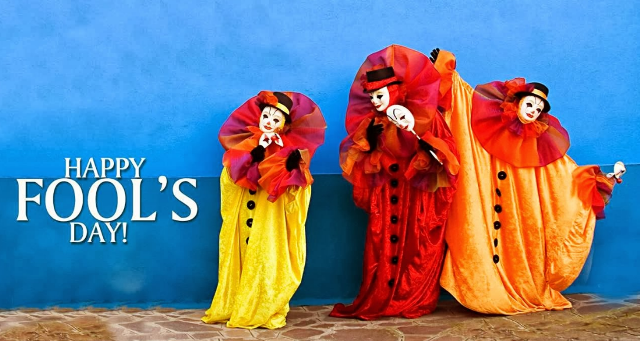
Fooling is Fun
April Fool’s Day or All Fool's Day is celebrated on April 1 across the globe, though it originated in Europe. Over the centuries, the day has thrown up some memorable pranks. Sudipto Maity lists a few
“April is the cruellest month stirring …” wrote Wasteland poet T.S. Eliot. But for many all over the world the month starts as a Fun day. Or April Fool’s Day. Making fun of others, playing a hoax, even giving a bad news which is not true, are all taken in with good humour.
According to popular beliefs, the early practices originated in France. It was the first country in Europe to implement Pope Gregory XIII’s order of replacing the old Julian calendar with the Gregorian Calendar in 1582.

New Year’s day was originally celebrated around April 1 as an advent of spring . With introduction of the Gregorian Calendar, the New Year’s date moved to January 1. Many people, who either refused to acknowledge the new date, or were unaware about the change, continued to celebrate New Year’s day on the old date. This prompted others to make fun of these traditionalists, sending them on fool’s errands. Eventually it became a ritual and spread throughout Europe.
However, this theory has been questioned by many who dismiss it for lack of evidence. As proof, they point out that while England did not adopt the Gregorian calendar until 1752, the tradition of April Fool’s Day was already well established there by then.
Constantine and Kugel
Another theory states that the tradition of April Fool’s Day dates back to the time of Constantine the Great and one of his court jesters, Kugel. Joseph Boskin, a professor of history at Boston University who was invited by the public relations team at the University to pitch in as an expert and speak on the origin of April Fool’s day.
Boskin told his audience that when a group of court jesters told Constantine that they could rule the kingdom better than him, he was amused and allowed a jester named Kugel to rule for a day. King Kugel, having ascended the throne, passed a proclamation calling for a celebration of absurdity on April 1. Later, it became an official event.
Sounds plausible? Associated Press thought so and ran the story. It took them a couple of weeks to realise that Boskin played a hoax on them.
"In a way, it was a very serious day. In those times fools were really wise men. It was the role of jesters to put things in perspective with humor," he told AP.
Boskin was accused of ruining the life of a young reporter working for AP, but he has since used the story as an example to teach his students the importance of cross-checking facts.
Up in the sky
Way back in the late Eightes or could be early 90s too, a leading Indian-English daily, The Statesman, informed its readers about an alien invasion that was going to take place on the night of April 1. The newspaper in a well crafted piece with convincing images in its Sunday supplement Miscellany ahead of the fool's day urged readers to look up in the sky. As luck would have it, the unsuspecting readers fell for the bait.
“It’s difficult to forget about that prank,” says senior journalist Sujoy Dhar, who was in his sophomore year then. He too was a ‘victim.’ And why not?
“It was unthinkable that a house we would associate with copybook journalism would indulge in a plan to fool its readers. Maybe that’s why so many believed in the fake news. Many were amused later when the paper later announced that it was a prank. But some were outraged too, hehe,” recalls Dhar.
Since then, many Indian news outlets have tried to fool its readers/viewers, but “haven't been able to emulate The Statesman's skill in presentation of the news or its success,” stresses Dhar.
Instant Colour TV
However many old timers in Europe recall how in the early 1960s, the Swedish national broadcaster had fooled people when they announced that new technology would help owners of black and white TV sets to convert them into colour sets by pulling a nylon stocking over the screen.

At the time, SVT (Sveriges Television) was the only television channel in Sweden. The broadcast was in black and white only.
Well, it took almost eight more years for people to watch colour TV in Europe when colour transmission began in 1970. The 1962 hoax transmission by the broadcaster of Sweden can still be watched on YouTube!!!
Of cockroaches and lizards
Among other things, Krishnanagar in West Bengal’s Nadia district is famous for its clay craft. In medieval times, a common practice among the natives was pranking relatives using objects made of clay. These objects, mostly resembled food (fruits, sea food) and insects, and due to the of artistry, they looked life-like.

Reminiscing about a prank she pulled on her colleagues once in Mumbai, travel writer Uttara Gangopadhyay shares, “It was April Fool’s Day and I could not resist taking to office a pair of cockroaches and a lizard that I had at home. I went to office early and placed those on the desktop keyboards and within files at random.
"Slowly people started trickling in, when suddenly the morning quiet was torn by a shrill cry. The lizard was discovered. The colleague who discovered it on her key board nearly fainted while others tried to shoo it from far."
And as luck would have it, one of the cockroaches was discovered too - another ear piercing cry and rushing around by a few who wanted to distance themselves from the offending animal.
Finally, a brave heart, armed with a long plastic ruler tried to shoo away the lizard, which refused to move. Some wondered if it was dead when suddenly someone tried to slide it off the keyboard by tilting it. It was then they discovered that the lizard was made of clay.
Somebody similarly hit at the cockroach and its clay identity established." She says.
Was she caught? Yes, and she still has the cockroaches!
A 'sweet' prank
The renowned Jolbhora Sandesh of Bengal may find takers aplenty, but do you know how it came into existence?
It was born due to one’s desire to fool an unsuspecting dear relative. The year was 1818.
According to descendants of the famous confectioner Modak, upon receiving instructions from the zamindar's wife, confectioner Surya Kumar Modak with his son Siddeshwar got down to work.

The instructions were clear, the mother-in-law wanted to play a prank on hernew son-in-law but wanted it to be subtle.
Modak came up with the idea of filling a large ‘Talsansh’ (a traditional Bengali dry sweetmeat) with rosewater and sweet syrup and it was presented to the new groom. As he took a bite, the water-filled centre crumbled, drenching his panjabi (Bengali style Kurta). What followed was a loud cheer from the mother-in-law. The rest is history.
Though the incident took place much before April Fool’s Day arrived in the country via the colonialists and gained a following, it remains a classic case of perfect execution of a prank.
Image on the Top of the Story: The top image is one of 2001 April Fool's Day in Denmark, regarding Copenhagen's new subway. It looks as if one of its cars had an accident, and had broken through and surfaced on the square in front of the town hall. In reality, it was a retired subway car from the subway of Stockholm cut obliquely. Image courtesy Lars Andersen, Wikimedia Commons
Support Our Journalism
We cannot do without you.. your contribution supports unbiased journalism
IBNS is not driven by any ism- not wokeism, not racism, not skewed secularism, not hyper right-wing or left liberal ideals, nor by any hardline religious beliefs or hyper nationalism. We want to serve you good old objective news, as they are. We do not judge or preach. We let people decide for themselves. We only try to present factual and well-sourced news.







